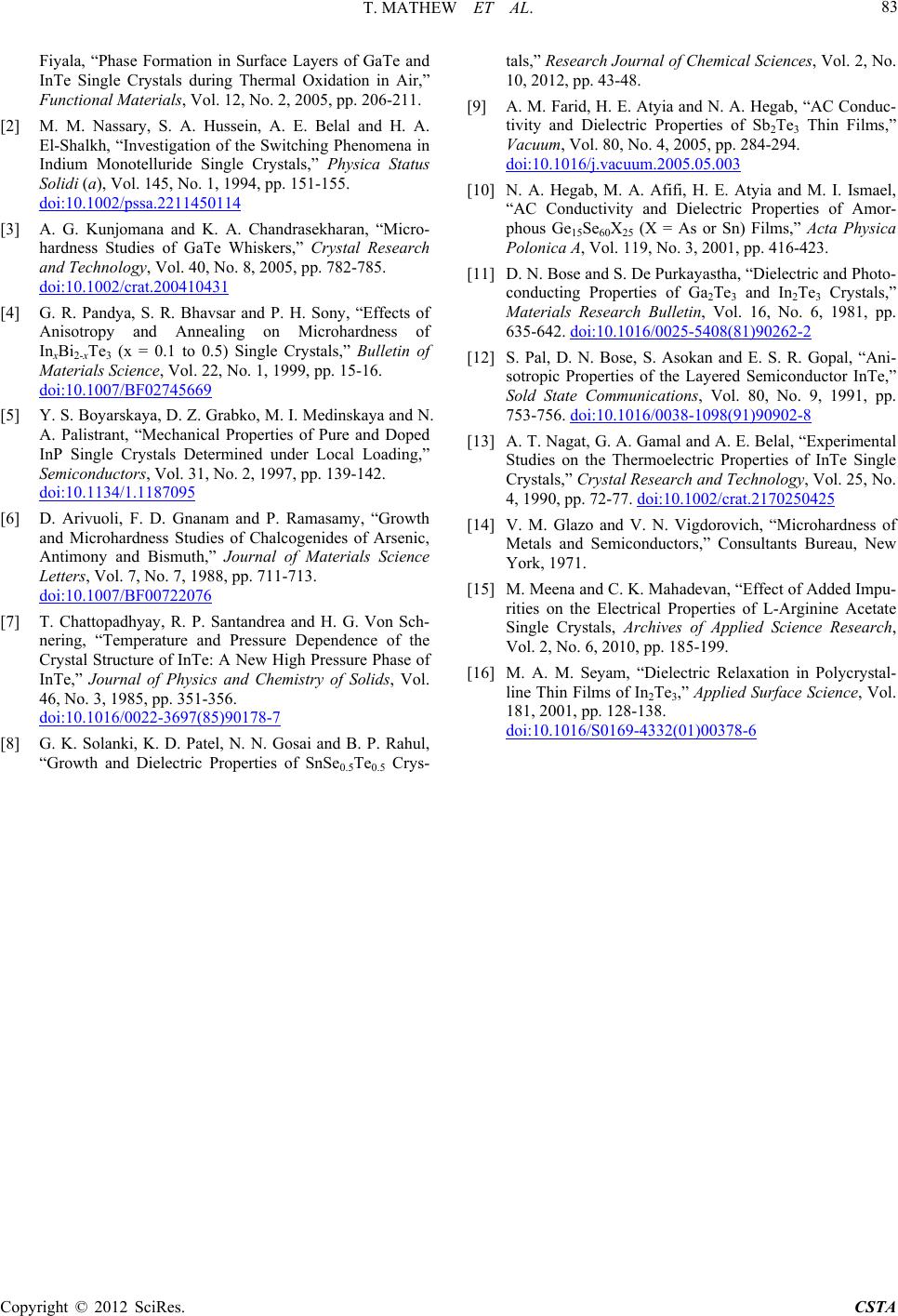
T. MATHEW ET AL.
Copyright © 2012 SciRes. CSTA
83
Fiyala, “Phase Formation in Surface Layers of GaTe and
InTe Single Crystals during Thermal Oxidation in Air,”
Functional Materials, Vol. 12, No. 2, 2005, pp. 206-211.
[2] M. M. Nassary, S. A. Hussein, A. E. Belal and H. A.
El-Shalkh, “Investigation of the Switching Phenomena in
Indium Monotelluride Single Crystals,” Physica Status
Solidi (a), Vol. 145, No. 1, 1994, pp. 151-155.
doi:10.1002/pssa.2211450114
[3] A. G. Kunjomana and K. A. Chandrasekharan, “Micro-
hardness Studies of GaTe Whiskers,” Crystal Research
and Technology, Vol. 40, No. 8, 2005, pp. 782-785.
doi:10.1002/crat.200410431
[4] G. R. Pandya, S. R. Bhavsar and P. H. Sony, “Effects of
Anisotropy and Annealing on Microhardness of
InxBi2-xTe3 (x = 0.1 to 0.5) Single Crystals,” Bulletin of
Materials Science, Vol. 22, No. 1, 1999, pp. 15-16.
doi:10.1007/BF02745669
[5] Y. S. Boyarskaya, D. Z. Grabko, M. I. Medinskaya and N.
A. Palistrant, “Mechanical Properties of Pure and Doped
InP Single Crystals Determined under Local Loading,”
Semiconductors, Vol. 31, No. 2, 1997, pp. 139-142.
doi:10.1134/1.1187095
[6] D. Arivuoli, F. D. Gnanam and P. Ramasamy, “Growth
and Microhardness Studies of Chalcogenides of Arsenic,
Antimony and Bismuth,” Journal of Materials Science
Letters, Vol. 7, No. 7, 1988, pp. 711-713.
doi:10.1007/BF00722076
[7] T. Chattopadhyay, R. P. Santandrea and H. G. Von Sch-
nering, “Temperature and Pressure Dependence of the
Crystal Structure of InTe: A New High Pressure Phase of
InTe,” Journal of Physics and Chemistry of Solids, Vol.
46, No. 3, 1985, pp. 351-356.
doi:10.1016/0022-3697(85)90178-7
[8] G. K. Solanki, K. D. Patel, N. N. Gosai and B. P. Rahul,
“Growth and Dielectric Properties of SnSe0.5Te0.5 Crys-
tals,” Research Journal of Chemical Sciences, Vol. 2, No.
10, 2012, pp. 43-48.
[9] A. M. Farid, H. E. Atyia and N. A. Hegab, “AC Conduc-
tivity and Dielectric Properties of Sb2Te3 Thin Films,”
Vacuum, Vol. 80, No. 4, 2005, pp. 284-294.
doi:10.1016/j.vacuum.2005.05.003
[10] N. A. Hegab, M. A. Afifi, H. E. Atyia and M. I. Ismael,
“AC Conductivity and Dielectric Properties of Amor-
phous Ge15Se60X25 (X = As or Sn) Films,” Acta Physica
Polonica A, Vol. 119, No. 3, 2001, pp. 416-423.
[11] D. N. Bose and S. De Purkayastha, “Dielectric and Photo-
conducting Properties of Ga2Te3 and In2Te3 Crystals,”
Materials Research Bulletin, Vol. 16, No. 6, 1981, pp.
635-642. doi:10.1016/0025-5408(81)90262-2
[12] S. Pal, D. N. Bose, S. Asokan and E. S. R. Gopal, “Ani-
sotropic Properties of the Layered Semiconductor InTe,”
Sold State Communications, Vol. 80, No. 9, 1991, pp.
753-756. doi:10.1016/0038-1098(91)90902-8
[13] A. T. Nagat, G. A. Gamal and A. E. Belal, “Experimental
Studies on the Thermoelectric Properties of InTe Single
Crystals,” Crystal Research and Technology, Vol. 25, No.
4, 1990, pp. 72-77. doi:10.1002/crat.2170250425
[14] V. M. Glazo and V. N. Vigdorovich, “Microhardness of
Metals and Semiconductors,” Consultants Bureau, New
York, 1971.
[15] M. Meena and C. K. Mahadevan, “Effect of Added Impu-
rities on the Electrical Properties of L-Arginine Acetate
Single Crystals, Archives of Applied Science Research,
Vol. 2, No. 6, 2010, pp. 185-199.
[16] M. A. M. Seyam, “Dielectric Relaxation in Polycrystal-
line Thin Films of In2Te3,” Applied Surface Science, Vol.
181, 2001, pp. 128-138.
doi:10.1016/S0169-4332(01)00378-6